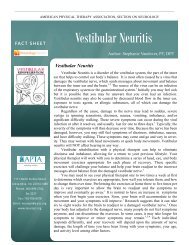Practice Guidelines for BPPV - Neurology Section
Practice Guidelines for BPPV - Neurology Section
Practice Guidelines for BPPV - Neurology Section
You also want an ePaper? Increase the reach of your titles
YUMPU automatically turns print PDFs into web optimized ePapers that Google loves.
Vestibular SIG Newsletter <strong>BPPV</strong> Special Edition<br />
Horizontal Canal <strong>BPPV</strong>-- other signs and tests<br />
By Anne Galgon (continued from page 4)<br />
involvement and results in more intense nystagmus. As a<br />
result, the intensity of the nystagmus and symptoms is the<br />
diagnostic criteria <strong>for</strong> side of localization in the SRT 6,11,12 .<br />
Rates of undetermined side of involvement with the SRT<br />
have been reported between 11.5 % and 16% in individuals<br />
with HC <strong>BPPV</strong> 2,3,14 . In most of these studies, the intensity<br />
of the nystagmus is recorded using infrared camera systems<br />
to measure the eye movement velocities of the nystagmus.<br />
Determining differences in intensity may be more difficult<br />
in physical therapy practices without this specific<br />
equipment.<br />
Summary of other signs and positional tests<br />
Other signs and positional tests that can be utilize when the<br />
side of involvement is undetermined with the SRT, include<br />
a sitting spontaneous nystagmus, the Head Pitch Test or<br />
Bow and Lean Test, the Supine to Sit Test and the Head<br />
Shake Test. Spontaneous nystagmus (or pseudo<br />
spontaneous nystagmus) in individuals with HC <strong>BPPV</strong> was<br />
first described by Bisdorff and Debatisse in 2001 8 . Since<br />
that time others have reported spontaneous nystagmus in<br />
upright sitting in 64-76% of individuals with HC <strong>BPPV</strong><br />
9,13,15 . Spontaneous nystagmus is a unique finding to HC<br />
<strong>BPPV</strong> and is not seen in any other <strong>for</strong>ms of <strong>BPPV</strong> 9 . The<br />
nystagmus is explained in HC <strong>BPPV</strong> due to the ~30 degree<br />
up pitch of the HCs in relationship to the upright head and<br />
the potential gravitational influence on the otoconia in the<br />
HC. By pitching the head up an additional 30 degrees the<br />
nystagmus intensifies and by pitching the head down 60<br />
degrees, the nystagmus will change directions. There<br />
should also be a “null point” where the nystagmus will go<br />
away, this occurs when the head is pitch down<br />
approximately 30 degrees and the HCs are perpendicular to<br />
the gravitational vector 8 . In a clinical exam changing the<br />
head position to provoke a change in nystagmus will be<br />
important to distinguish these signs from spontaneous<br />
nystagmus associated with an acute vestibular sensory<br />
imbalance such as a unilateral peripheral hypofunction.<br />
The up pitch and down pitch head positions together, the<br />
Head Pitch Test (HPT) 13 or Bow and Lean Test (BLT) 14 ,<br />
may further differentiate between sides of involvement.<br />
The upward pitch (or lean) creates a horizontal nystagmus<br />
away from the side of involvement in the geotropic <strong>for</strong>m<br />
and toward the side of involvement in the apogeotropic<br />
<strong>for</strong>m. The downward pitch (Bow) creates a horizontal<br />
12<br />
nystagmus towards the side of involvement in the<br />
geotropic and away from the side of involvement in the<br />
apogeotropic <strong>for</strong>m 2,3,9,12,13-14 . Positive findings on the<br />
BLT (or HPT) have been reported in 72% 3 and 76.8% 2<br />
in individuals with HC <strong>BPPV</strong>. These authors reported<br />
that adding these positional tests increase the ability to<br />
localize side of involvement and increased the success<br />
rate of the canalith repositioning maneuver (CRM)<br />
intervention 2,3,14 . Lee and colleagues 2 compared success<br />
rates after first CRM in individuals diagnosed with the<br />
SRT alone or with the SRT and the BLT together. The<br />
success rate increased from 67.4%, (SRT alone) to 83.1%<br />
with BLT added in individuals with geotropic <strong>for</strong>m, and<br />
increased from 61.1% to 74.7% in the apogeotropic <strong>for</strong>m.<br />
When there is a discord between the interpretation of side<br />
of involvement in the SRT and the BLT, they argued that<br />
the BLT localized the side of involvement better, because<br />
the CRM reduced nystagmus more effectively when the<br />
direction of the CRM (Log Roll maneuver) was<br />
determined by the BLT. 2,14 The BLT may not assist as<br />
well in identifying side in the apogeotropic <strong>for</strong>m, as one<br />
study 1 only reported positive findings on this test in 24%<br />
of a group of 64 individuals with apogeotropic HC<br />
<strong>BPPV</strong>.<br />
Moving the patient from long sitting to supine and<br />
observing <strong>for</strong> nystagmus, the Sit to Supine Test (SST),<br />
is another option to identify side of involvement 4,13,15 .<br />
The SST reproduces the same effect on the HCs as the up<br />
pitch or lean component of the BLT, but moves the head<br />
through a greater excursion resulting in a more likely<br />
provocation of a positional nystagmus following the<br />
same directional rules of the upward pitch of the head.<br />
(In supine: horizontal nystagmus beats away from the<br />
side of involvement in the geotropic <strong>for</strong>m and toward the<br />
side of the involvement in the apogeotropic <strong>for</strong>m.)<br />
Asprella-Libonati 13,15 and Han et al 4 both independently<br />
recommended this test as the best method to identify side<br />
of involvement when a difference in intensity could not<br />
be distinguished with the SRT. A positive horizontal<br />
nystagmus on the SST has been reported in between 75%<br />
1 and 96% 13 of patients with HC <strong>BPPV</strong>. Asprella-<br />
Libonata 13,15 developed clinical recommendations <strong>for</strong><br />
identifying side of involvement using combination of<br />
SRT, spontaneous nystagmus, and the SST together. For<br />
the geotropic <strong>for</strong>m of HC <strong>BPPV</strong> the involved side will<br />
be:

















